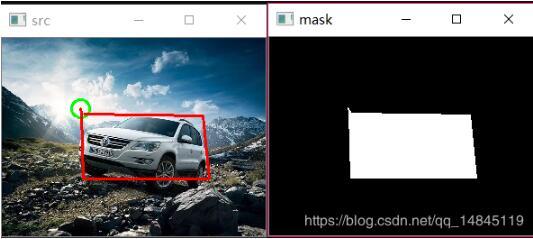废话不多说,直接上代码吧!
# -*- coding: utf-8 -*- import cv2 import numpy as np # -----------------------鼠标操作相关------------------------------------------ lsPointsChoose = [] tpPointsChoose = [] pointsCount = 0 count = 0 pointsMax = 10 def on_mouse(event, x, y, flags, param): global img, point1, point2, count, pointsMax global lsPointsChoose, tpPointsChoose # 存入选择的点 global pointsCount # 对鼠标按下的点计数 global img2, ROI_bymouse_flag img2 = img.copy() # 此行代码保证每次都重新再原图画 避免画多了 # ----------------------------------------------------------- # count=count+1 # print("callback_count",count) # -------------------------------------------------------------- if event == cv2.EVENT_LBUTTONDOWN: # 左键点击 pointsCount = pointsCount + 1 # 感觉这里没有用?2018年8月25日20:06:42 # 为了保存绘制的区域,画的点稍晚清零 # if (pointsCount == pointsMax + 1): # pointsCount = 0 # tpPointsChoose = [] print('pointsCount:', pointsCount) point1 = (x, y) print (x, y) # 画出点击的点 cv2.circle(img2, point1, 10, (0, 255, 0), 2) # 将选取的点保存到list列表里 lsPointsChoose.append([x, y]) # 用于转化为darry 提取多边形ROI tpPointsChoose.append((x, y)) # 用于画点 # ---------------------------------------------------------------------- # 将鼠标选的点用直线连起来 print(len(tpPointsChoose)) for i in range(len(tpPointsChoose) - 1): print('i', i) cv2.line(img2, tpPointsChoose[i], tpPointsChoose[i + 1], (0, 0, 255), 2) # ---------------------------------------------------------------------- # ----------点击到pointMax时可以提取去绘图---------------- if (pointsCount == pointsMax): # -----------绘制感兴趣区域----------- ROI_byMouse() ROI_bymouse_flag = 1 lsPointsChoose = [] cv2.imshow('src', img2) # -------------------------右键按下清除轨迹----------------------------- if event == cv2.EVENT_RBUTTONDOWN: # 右键点击 print("right-mouse") pointsCount = 0 tpPointsChoose = [] lsPointsChoose = [] print(len(tpPointsChoose)) for i in range(len(tpPointsChoose) - 1): print('i', i) cv2.line(img2, tpPointsChoose[i], tpPointsChoose[i + 1], (0, 0, 255), 2) cv2.imshow('src', img2) def ROI_byMouse(): global src, ROI, ROI_flag, mask2 mask = np.zeros(img.shape, np.uint8) pts = np.array([lsPointsChoose], np.int32) # pts是多边形的顶点列表(顶点集) pts = pts.reshape((-1, 1, 2)) # 这里 reshape 的第一个参数为-1, 表明这一维的长度是根据后面的维度的计算出来的。 # OpenCV中需要先将多边形的顶点坐标变成顶点数×1×2维的矩阵,再来绘制 # --------------画多边形--------------------- mask = cv2.polylines(mask, [pts], True, (255, 255, 255)) ##-------------填充多边形--------------------- mask2 = cv2.fillPoly(mask, [pts], (255, 255, 255)) cv2.imshow('mask', mask2) cv2.imwrite('mask.jpg', mask2) ROI = cv2.bitwise_and(mask2, img) #cv2.imwrite('ROI.bmp', ROI) #cv2.imshow('ROI', ROI) # -----------------------定点ROI绘制,程序中未使用------------------- def fixed_ROI(): mask = np.zeros(img.shape, np.uint8) pts = np.array([[x1, y1], [x2, y2], [x3, y3], [x4, y4]], np.int32) # 顶点集 pts = pts.reshape((-1, 1, 2)) mask = cv2.polylines(mask, [pts], True, (255, 255, 255)) mask2 = cv2.fillPoly(mask, [pts], (255, 255, 255)) cv2.imshow('mask', mask2) # cv2.imwrite('mask.bmp', mask2) # cv2.drawContours(mask,points,-1,(255,255,255),-1) ROI = cv2.bitwise_and(mask2, img) cv2.imshow('ROI', ROI) # cv2.imwrite('ROI.bmp', ROI) img = cv2.imread('yuantu.jpg') # --------------------------------------------------------- # --图像预处理,设置其大小 # height, width = img.shape[:2] # size = (int(width * 0.3), int(height * 0.3)) # img = cv2.resize(img, size, interpolation=cv2.INTER_AREA) # ------------------------------------------------------------ ROI = img.copy() cv2.namedWindow('src') cv2.setMouseCallback('src', on_mouse) cv2.imshow('src', img) cv2.waitKey(0)
以上这篇python3+opencv生成不规则黑白mask实例就是小编分享给大家的全部内容了,希望能给大家一个参考,也希望大家多多支持python博客。
-
<< 上一篇 下一篇 >>
标签:numpy
python3+opencv生成不规则黑白mask实例
看: 995次 时间:2020-12-15 分类 : python教程
- 相关文章
- 2021-12-20Python 实现图片色彩转换案例
- 2021-12-20python初学定义函数
- 2021-12-20图文详解Python如何导入自己编写的py文件
- 2021-12-20python二分法查找实例代码
- 2021-12-20Pyinstaller打包工具的使用以及避坑
- 2021-12-20Facebook开源一站式服务python时序利器Kats详解
- 2021-12-20pyCaret效率倍增开源低代码的python机器学习工具
- 2021-12-20python机器学习使数据更鲜活的可视化工具Pandas_Alive
- 2021-12-20python读写文件with open的介绍
- 2021-12-20Python生成任意波形并存为txt的实现
-
搜索
-
-
推荐资源
-
Powered By python教程网 鲁ICP备18013710号
python博客 - 小白学python最友好的网站!